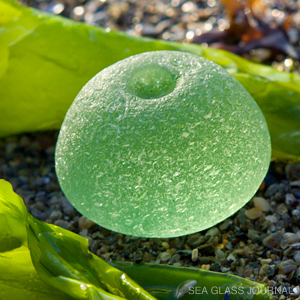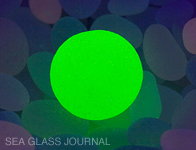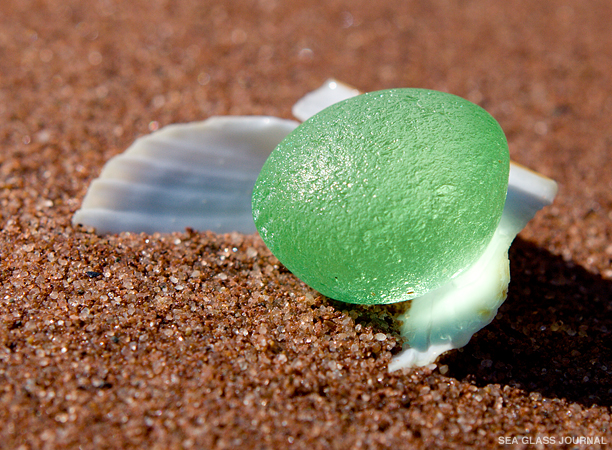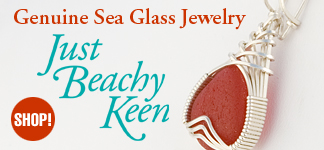The Sea Glass Shard of the Month: April 2014
A Depression-Era Vaseline Glass Drawer Pull

This sea glass was once possibly a decorative drawer pull knob from the Depression era.
Sea Glass Specifications:
Color: Yellow-Green
Diameter: 19.1 mm (0.75") at widest
Thickness: 15.9 mm (0.625")
Weight: 10.6 grams (0.38 ounces)
This sea glass specimen might possibly be a Depression-era drawer pull made of vaseline glass. Vaseline glass is a term commonly used for the transparent yellow to yellow-green glass that owes its color to the presence of uranium.
The simplest way to determine if a piece of sea glass is vaseline glass is to expose it to an ultraviolet light source such as a black light. The uranium will fluoresce (glow) a vivid yellow-green color. As shown in the photo below, it is obvious that this sea glass knob contains uranium. This is the first clue to the shard's history.

The presence of uranium causes this sea glass to glow a vivid green when placed under a black light.
The original name for vaseline glass is canary glass, due to the pronounced yellow tinge when first produced in the 1840s. The term "vaseline glass" comes from the similarity to the appearance of petroleum jelly produced in the early part of the 20th Century[1].
Vaseline glass, along with custard glass and Burmese glass, are collectively know as uranium glass due to the uranium salts (uranium dioxide) used in each. Its popularity peaked from the 1880s to the 1920s when it was often used in making tableware and decorative items.
The small dimple at the narrow end suggests the vestige of a screw hole, which could have been used to secure the pull knob to the drawer. The petite size also suggests it was used in a jewelry box or small cabinet.
"The simplest way to determine if a piece of sea glass is vaseline glass is to expose it to an ultraviolet light source."
During the Depression, iron oxide was often added to the uranium-glass mixture to emulate the green tinge of some popular Depression glass of that era. Since this sea glass knob has that greenish tinge this is also a clue that helps in dating it.
With the outbreak of WWII all stocks of uranium were confiscated by the US government, effectively halting the production of uranium glass. After the war, a lower grade version of uranium (depleted uranium) was used for vaseline glass production, which resulted in a less pronounced glow to sea glass shards when exposed to UV light.
While we can't be sure of this sea glass knob's exact origin, we can certainly piece together a well educated guess of its history.
REFERENCES:
1. Wikipedia: Uranium Glass

Keep up-to-date on all things sea glass... "Like Us" on Facebook!
Sea Glass Journal on Facebook






